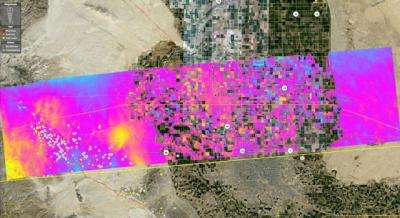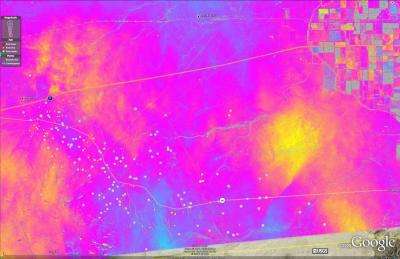NASA Images Show Continuing Mexico Quake Deformation

(PhysOrg.com) -- New NASA airborne radar images of Southern California near the U.S.-Mexico border show Earth's surface is continuing to deform following the April 4 magnitude, 7.2 temblor and its many aftershocks that have rocked Mexico's state of Baja California and parts of the American Southwest.
The data, from NASA's airborne Uninhabited Aerial Vehicle Synthetic Aperture Radar (UAVSAR), reveal that some faults in the area west of Calexico, Calif., have continued to move at Earth's surface, most likely in the many aftershocks. This fault motion is likely to be what is known as "triggered slip," caused by changes in stress in Earth's crust from the main quake rupture. The new maps, called interferograms, were created by combining data from flights on April 13, 2010, and July 1, 2010, and can be found here. Previous radar maps of the region released on June 23, 2010, are here.
The first image shows a UAVSAR interferogram swath measuring 87 by 20 kilometers (54 by 12.5 miles) overlaid atop a Google Earth image. Each colored contour, or fringe, of the interferogram represents 11.9 centimeters (4.7 inches) of surface displacement. The different shades in the image represent ground surface motions of up to a few inches upward or downward. Yellow shaded regions moved to the south or downward, regions in blue moved to the north or upward, and regions shaded in magenta showed no motion. Major fault lines are marked in red, and recent aftershocks are denoted by yellow, orange and red dots, with older earthquakes shown as gray dots.

An enlargement of the interferogram is shown in the second image. This image focuses on the area where most of the aftershocks have been located, west of Calexico. The enlargement, which covers an area measuring about 28 by 18 kilometers (18 by 11.5 miles), reveals many small "cuts," or discontinuities, in the interferogram color. These are caused by ground motions on small faults that have occurred since April 13, ranging from less than a centimeter to a few centimeters (half an inch to a few inches). The thin, colored lines represent faults previously mapped by the U.S. and California Geological Surveys through the end of 2009.
A science team at NASA's Jet Propulsion Laboratory, Pasadena, Calif., is using the JPL-developed UAVSAR to measure surface deformation from the quake. The radar flies at an altitude of 12.5 kilometers (41,000 feet) on a Gulfstream-III aircraft from NASA's Dryden Flight Research Center, Edwards, Calif.
The team uses a technique that detects minute changes in the distance between the aircraft and the ground over repeated, GPS-guided flights.
JPL geophysicist Andrea Donnellan, principal investigator of the UAVSAR project to map and assess seismic hazard in Southern California, said the latest flight provides valuable new data that researchers can use to monitor the continued readjustment of Earth's crust since April's major quake. "The region was reflown with UAVSAR to monitor continued activity, including quiet motions--which are movements of faults that do not result in earthquakes--as Earth's crust readjusts, as well as large aftershocks, such as the magnitude 5.7 quake observed on June 14," she said.
The April 4, 2010, El Mayor-Cucapah quake was centered 52 kilometers (32 miles) south-southeast of Calexico, Calif., in northern Baja California. The quake, the region's largest in nearly 120 years, was also felt in southern California and parts of Nevada and Arizona. There have been thousands of aftershocks, extending from near the northern tip of the Gulf of California to a few miles northwest of the U.S. border. The area northwest of the main rupture, along the trend of California's Elsinore fault, has been especially active.
Geologists used the first UAVSAR interferogram, which included the April 4th quake, to map many new, small fault ruptures in the field. JPL geophysicist Eric Fielding said, "This new interferogram shows that some of the faults have continued to slip since our overflight on April 13th. Such mapping is important for understanding the fault structure in this area between the main fault ruptures on April 4th farther south in Baja California and the faults farther to the north in Southern California, including the Elsinore and San Jacinto faults."
Fielding's studies of interferograms from Japanese and European Space Agency satellites indicate the largest fault movement visible in the new UAVSAR interferogram occurred between May 21 and June 6 along a northeast-southwest trending fault known as the Yuha fault, visible to the right of the center of the interferogram. This fault previously had slipped about 2 to 4 centimeters (1 to 2 inches) in the first days after the April 4th earthquake, as was shown in the earlier UAVSAR and satellite interferograms. Since April 13, the fault has slipped about another 2 centimeters (1 inch).
The fact that the Yuha fault has a trend towards the northeast is also significant, Fielding added, because it is very different from the northwest-trending major Elsinore and San Jacinto fault systems and the faults in Mexico that ruptured in the main earthquake. "This adds to evidence that the faults in Mexico are not directly connected to the Elsinore and San Jacinto faults and may explain why the magnitude 7.2 April 4 earthquake stopped before it reached California," he said.
The full-resolution data for the new interferogram displayed in Google Earth are available here.
Provided by JPL/NASA


















